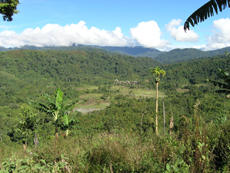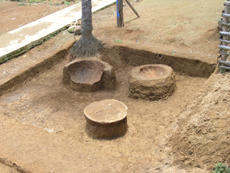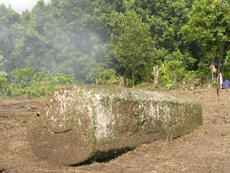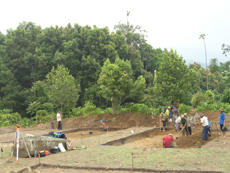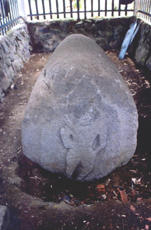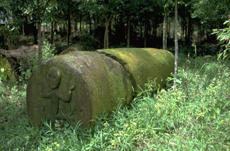Short report of the 2nd archaeological campaign
Short report of the 2nd archaeological campaign in Kerinci/Serempas (Indonesia)
from the 28th of February until the 31st of March 2005
In spring 2005 the archaeological project was continued, funded by the Swiss-Liechtenstein Foundation for Archaeological Research Abroad (SLSA). The team consisted of members from the Free University of Berlin/Germany, the University of Bern/Switzerland, Yale University/USA and from three different archaeological institutions in Indonesia ( Jakarta, Palembang, Jambi).
The archaeological research focused the following:
-
the excavation in Renah Kemumu/Serempas
-
the excavation near the megalith Bukit Batu Larung near Renah Kemumu/Serempas
-
a megalith survey in the whole region of Kerinci, Serempas and the Sungai Tenang-region.
|
|
|
|
Fig. 1 |
Fig. 2 |
Adjacent to the highland of Kerinci lies Serempas, a remote forest area which forms part of the protected National Park. The village Renah Kemumu (fig. 1) is reached in one or two trekking days. Here 35 jars are found. These jars with diameters ranging from 0.60 and 1.20m were buried in the earth so that only their rims, which are eroded, were visible at the surface. Four of these jars were excavated (fig. 2). Most of the rim sherds fell into the interior of the jar. In between and underneath these sherds fragments of other smaller pots were found. Earth samples were taken which might give the evidence of a human burial.
|
|
|
|
Fig. 3 |
Fig. 4 |
The excavation near the megalith was pursued on a slope in the south of the valley of Renah Kemumu at the Bukit Batu Larung. The megalith is 3.20m long with two drum-like ends (fig. 3). One side shows a relief: a human figure which seems to kneel on the ground. Around the megalith, six areas were laid out for an excavation (fig. 4). In the East and in the west of the megalith loose structures of burnt clay were discovered which seem to have been used as fire- or hearth places. Round stones, hard burnt clay balls, glass beads and metal tools were found next to numerous pottery sherds. In the southern area a flat stone was discovered which served as grounding stone underneath a house post. The activities indicated by the archaeological artifacts did not take place in close proximity to the megalith but at a further distance. Settlement activities are observed on the summit of the slope.
|
|
In the areas of South of the lake Kerinci, in Serampas and further east in the Sungai Tenang area 19 megaliths were surveyed (figs. 5-6). Some of which were unknown until now. Around the lake of Kerinci eight megaliths form a coherent stylistic group considering their shape and decoration. They are either conical or canon-like in shape and measure up to 3m in length (figs. 5-6). |
| Fig. 5 |
In the eastern areas the megaliths are in general longer and elongated figures decorate the well-rounded surfaces. The motives are the same in all three regions. Most of the megaliths are situated on slopes or reveal a direct connection to the surrounding mountain peaks. This far stretching mountainous region including the areas of Kerinci, Serempas and Sungai Tenang form one cultural unit connected by their megalithic remains.
|
|
|
|
|
Fig. 6 |
